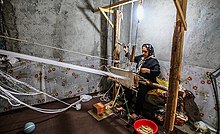|
Jajim Jajim (Persian: جاجیم; Azerbaijani: Cecim; Turkish: Cicim; Russian: Джаджим) also spelled as gelims, or jajim-bafi,[1] is a handmade, flat-woven textile made of colored natural fiber which is created and used in the majority of villages and rural areas of Iran.[2][3] Other locations the Jajim is found include Azerbaijan, Turkey, and India. About The nomadic Shahsevan people are thought to be the originators of the handicraft.[4] Jajim is a thicker textile, similar to a blanket. The yarn used to created Jajim are either wool, cotton, or a wool and cotton-blend. In contrast to the classically woven kilims and carpets which is a single panel, to weave a Jajim you create multiple narrow woven panels (often 4) and the panels are sewn together.[5] They traditionally were used as way for nomadic people to pack their belongings for migration.[6] They have also been used as a mattress, to wrap a bed,[7] as a korsi cover (a table heater),[7] as a curtain,[5] as a tent,[5] and as a carpet. After a Qashqai bride and groom are married, they use Jajim to create a ceremonial tent.[5] Since 2020, the Iran Ministry of Cultural Heritage, Handicrafts and Tourism has been investing money in promoting the ancient craft through an educational program.[1] Several museum collections have Jajims, include at the Fine Arts Museums of San Francisco (FAMSF).[8] See alsoReferencesWikimedia Commons has media related to Jajim.
|